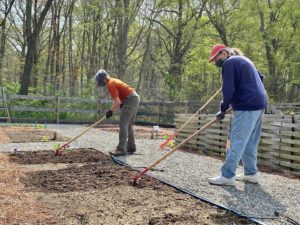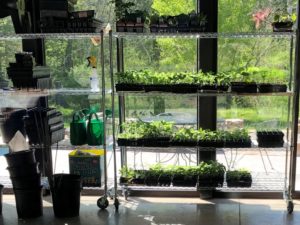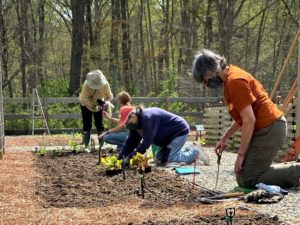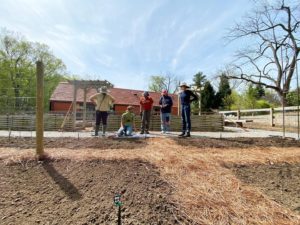
It’s human nature to want to know what is going on and who is behind what is currently being grown in Lucille’s Garden, and the tasks volunteers have undertaken to make it so. What motivates volunteers to work nine months a year in all kinds of weather, from 98 degrees to 28 degrees Fahrenheit, in rain and snow, and everywhere in between?
The purpose of Lucille’s Garden is to grow beautiful, organic and tasty vegetables, and to inspire everyone to grow food to help sustain themselves and their community. This year’s focus is to welcome all to the world of vegetables – sharing the bounty of distant food cultures reflected in our modern-day table. For 2021, we highlight our nation of immigrants.
As is typical with most gardens, some of our plants are grown indoors from seed and then transplanted to the garden, and others are directly sown into the prepared ground of the garden. This means volunteers begin sowing seeds indoors in late February or early March to make possible the transplanting of 300-500 plants.

The garden has been redesigned this year to include five gardens within one large garden. They are:
- The Asian Garden (vegetables spanning many continents)
- The Colonial Kitchen Garden (vegetables from the period of the Minshall Family – mid 18th century Europe with food crops found in the Americas, traditionally grown by the First People)
- The Cottage Garden (more free-form style, and an antidote for perfectionists)
- Solanaceous (Nightshade) Botanical Studies Beds (looking at similarities and differences)
- Pollinator Pocket Gardens (to support the pollinators), along with flowers, terracotta pots lining the main walkways.

Beginning in March, the volunteers start the outdoor work of getting the garden ready for spring. Their tasks include:
- Cleaning up debris deposited during the winter.
- Taking down hoop houses used to shelter microgreens from the cold.
- Preparing the beds for direct seeding and transplanting.
- Putting in posts for fencing to encourage vertical growth of tomatoes.
- Laying out pine needle path to make weeding and harvesting easier.
- Building trellises out of pussy willow branches (for the Colonial Garden).
- Lining elevated beds.
- Weeding and then mulching, so as not to have endless weeds throughout the three growing seasons, which takes time away from putting our energy into our vegetables and fruits.
The list goes on! Through the efforts of the 30 volunteers who work at Lucille’s Garden, you will see the following growing this spring (to name just a few):

In the Asian Garden
Sorrel (Red Veined), pak choi (Shanghai Green), mizuna, tatsoi (Red), carrot (Dragon Purple), spinach (Joker Asian), and radish (Japanese Wasabi)
In the Colonial Garden
Pea, leek (Giant Musselburgh), beet, (Ruby Queen), kale, mustard (India Florida Broadleaf), yellow onion (Bridger), swiss chard (Fordhook Giant), lettuce (Black Seeded Simpson), Italian parsley
In the Cottage Garden
Potato (Yukon Gem Gold), rhubarb, and asparagus (Jersey Supreme) all started from plant root or seed potato, Alyssum (White), calendula (Cantaloupe), pansy, violet, and viola will line the pathways for a beautiful floral display.
In the Solanaceous (Nightshade) Botanical Studies Bed
Potato (Huckleberry, King Harry, All Blue, Russian Banana Fingerling), Mesclun Blend, Green Rose Orach, Swiss chard (Rainbow, Lettuce (Tennis Ball), beet (Detroit and Crosby’s Egyptian), carrot (Kuroda), radicchio (Perseo). The terracotta pots will be filled with artichoke, pea, alyssum, viola and pansy.
The volunteers who help make Lucille’s Garden range in age from their early 20s to their late 70s. Some of them are new to the garden this year, and others have been here for a dozen years or more. Here’s what they say about why they do the hard work:
To:
- Learn from and about each other.
- Receive education and inspiration for their own gardens.
- Send healthy food to the Media Food Bank to those who are food insecure, and contribute to the wider community.
- Return to what we did as children – it feels so natural.
- Be outdoors, smell the air and feel the breeze.
- Work in harmony with nature.
- Get our hands in the earth and play in the dirt.
- See and be part of the growth process from seed to harvest.
- Contribute to land stewardship.
- Participate in Tyler’s mission.
- Be a part of a community with shared values.
- See food at the beginning (when planted) as opposed to just at the end (in the supermarket).
- Make new friends.
- Enjoy great conversations.
- Practice optimism.
- Give back to Tyler all the enjoyment it has given us.
Given all this, how about stopping by Lucille’s Garden and see what we’ve been up to this spring? And don’t forget to visit us in the summer and fall knowing the content of the Garden changes with each season. We look forward to seeing you soon!







